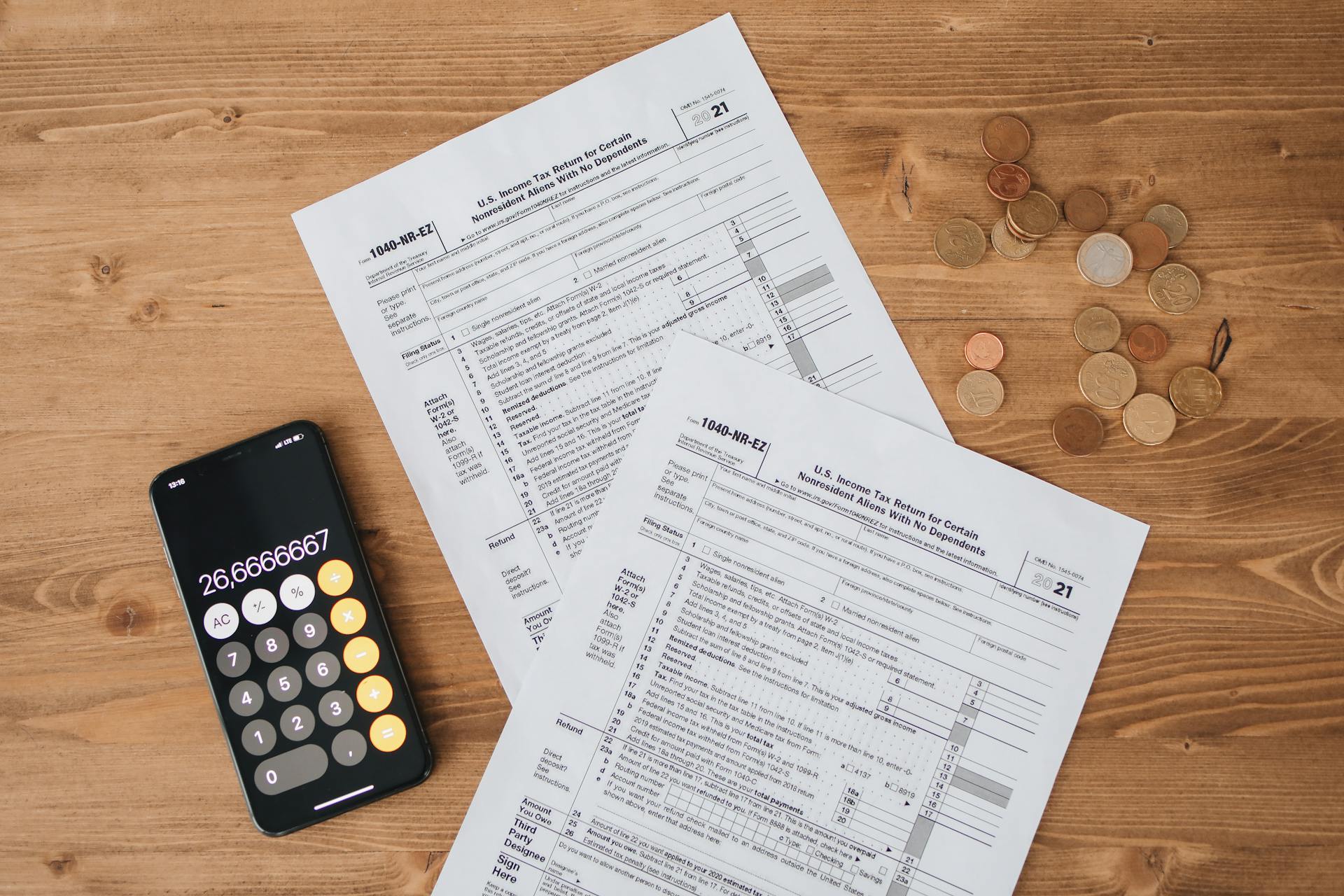
Foreign investments can be a great way to diversify your portfolio, but they also come with their own set of tax implications. If you're receiving foreign dividends, you might be wondering how to claim a tax credit.
In the United States, foreign dividend tax credits can be claimed on qualified foreign dividends received from certain countries. For example, the US has tax treaties with several countries that exempt dividends from withholding tax, such as Canada and the UK.
If you're an individual investor, you can claim a foreign dividend tax credit on your US tax return. This can help reduce your tax liability and increase your after-tax returns.
Discover more: Countries with Lowest Business Taxes
What is Foreign Dividend Tax Credit?
The foreign dividend tax credit is a tax benefit that allows you to offset income taxes paid to foreign countries or U.S. possessions.
It's essentially a way to reduce your U.S. tax liability and avoid double taxation on the same income earned internationally.
The foreign tax credit is available to U.S. citizens or resident aliens who have paid taxes on their foreign-earned income.
This credit can be a big help in reducing your tax burden, especially if you have investments or income from abroad.
By claiming the foreign dividend tax credit, you can effectively reduce your U.S. tax liability.
Claiming Credit with Software
Tax software can be a game-changer when it comes to claiming the foreign tax credit. It helps accountants calculate the credit and reduce the risk of double taxation for their clients.
Accountants can input financial data from various sources, including foreign income, in a streamlined manner using tax software. This saves time and effort, making the process more efficient.
Comprehensive tax software receives real-time updates and alerts regarding changes in tax laws and legislation, including those related to the foreign tax credit. This ensures that accountants and clients are aware of any changes that impact their tax obligations.
If you're an accountant looking to help your clients report on foreign income, you can use software that integrates with popular tax preparation programs like UltraTax CS, GoSystem Tax RS, CCH Axcess Tax, and Lacerte.
Additional reading: First Time Business Owner Filing Taxes
Understanding Dividends
Foreign dividends are essentially dividend payments received from companies based outside of the United States.
For US taxpayers, these dividends are considered part of their global income and are subject to US taxation, regardless of the tax policies of the country where the dividend originates.
It's essential to distinguish foreign dividends from domestic dividends because the US tax treatment involves specific reporting requirements.
Consider reading: Ubs Ag Dividend
Definition of High Kickout
A high tax kickout is a provision that prevents taxpayers from receiving a credit for foreign taxes paid at a rate significantly higher than the U.S. tax rate.
If the foreign tax rate on a particular item of income exceeds 250% of the U.S. tax rate, the excess foreign taxes paid are not eligible for the foreign tax credit.
For example, if a foreign country has a tax rate of 50% and the U.S. tax rate on the same income is 20%, the high tax kickout provision comes into play.
Only 20% of the foreign taxes paid would be eligible for the foreign tax credit, and the excess 30% would not qualify.
It's essential to be aware of the high tax kickout provision when calculating the foreign tax credit to ensure accurate compliance with tax regulations.
For another approach, see: High Credit Limit Cards for Fair Credit
What Are Dividends?
Dividends are payments made by companies to their shareholders, representing a portion of the company's profits.
Domestic dividends are paid by companies based in the United States, while foreign dividends come from companies based outside the country.
As a US taxpayer, you're subject to US taxation on foreign dividends, regardless of the tax policies in the country where the dividend originates.
Foreign dividends are distinct from domestic dividends, with specific reporting requirements and potential for a tax credit to avoid double taxation.
For your interest: Irs Debt Consolidation Companies
US Dividend Policy
US Dividend Policy is pretty straightforward: if you're a US person, you're subject to US tax on your global income, including foreign dividends. This includes citizens, dual nationals, Green Card holders, resident aliens, and domestic legal entities.
You'll need to report and potentially pay taxes on these earnings in the US. The tax rates and specifics may vary depending on agreements between the US and the country from which you receive dividends.
However, to avoid double taxation, you can claim a Foreign Tax Credit (FTC) if you paid taxes on these dividends to the foreign country. This credit reduces your US tax liability on a dollar-for-dollar basis for the amount of foreign taxes paid.
International Aspects
If you're a US person, you're subject to US tax on your global income, which includes foreign dividends.
Foreign dividends are taxable in the US, regardless of tax treaties between the US and the country from which you receive dividends.
You can claim a Foreign Tax Credit (FTC) to reduce your US tax liability on a dollar-for-dollar basis for the amount of foreign taxes paid.
This credit helps avoid double taxation, where you're taxed both in the source country and the US.
US tax rates and specifics may vary depending on agreements between the US and the country from which you receive dividends.
To claim an FTC, you'll need to report and potentially pay taxes on foreign dividends in the US.
Foreign tax credits can be a valuable tool for reducing your US tax liability, but you'll need to navigate the specific requirements and rules.
Curious to learn more? Check out: Quit Claim Deed Capital Gains Taxes
Forms and Compliance
You'll need to receive a Form 1099-DIV from your mutual fund to claim the foreign tax credit based on your share of foreign income taxes paid by the fund.
To choose between the foreign tax credit and an itemized deduction, you must itemize deductions on Form 1040, Schedule A. If you choose the foreign tax credit, you'll generally need to complete Form 1116 and attach it to your Form 1040.
You can't take the foreign tax credit on income you excluded using the foreign tax exclusion, so be sure to understand the rules before claiming the credit.
The IRS gives taxpayers the option of either deducting the foreign income tax they paid or claiming those taxes as a foreign tax credit (FTC).
To claim the foreign tax credit, file IRS Schedule 3 on your Form 1040; you may also have to file Form 1116.
Here are the conditions to meet when choosing to claim the foreign tax credit:
- All of your gross foreign source income was from interest and dividends and all of that income and the foreign tax paid on it were reported to you on Form 1099-INT, Form 1099-DIV, or Schedule K-1.
- If you had dividend income from shares of stock, you held those shares for at least 16 days.
- You are not filing Form 4563 (Exclusion of income for bona fide residents of American Samoa) or excluding income from sources within Puerto Rico.
- The total of your foreign taxes was not more than $300, or $600 if married filing jointly.
- All of your foreign taxes were paid on income that was subject to tax in the foreign country.
Impact and Strategies
The foreign dividend tax credit can have a significant impact on your taxes, especially if you hold international stock funds. For example, if you hold a fund that earns $1000 in dividends with $70 in foreign tax withheld, you'll only receive $930 in dividends.
You'll report the full $1000 in dividends on your Form 1099-DIV, along with the $70 in foreign tax withheld. Without the foreign tax credit, you'd owe tax on the full $1000, resulting in a total tax impact of $241.
The foreign tax credit can reduce your tax liability by up to $70, depending on your tax bracket and the amount of qualified dividends. This can result in a total tax impact of $171, including only $101 for U.S. taxes and $70 in foreign withholding.
You have a choice when it comes to dealing with foreign taxes: you can deduct them on Schedule A, claim the Foreign Tax Credit on Form 1116, or use Form 2555 to claim the Foreign Earned-Income Exclusion.
In most cases, choosing the Foreign Tax Credit will reduce your U.S. tax liability the most. This is because it allows you to subtract the taxes you paid to another country from your U.S. tax liability, resulting in a lower overall tax bill.
Here are the main options for avoiding double taxation on Americans living abroad:
- Deduct foreign taxes on Schedule A
- Claim the Foreign Tax Credit on Form 1116
- Use Form 2555 to claim the Foreign Earned-Income Exclusion
Keep in mind that choosing the Foreign Tax Credit will generally result in the lowest U.S. tax liability, as it allows you to subtract the foreign taxes you've already paid.
Sources
- https://tax.thomsonreuters.com/blog/foreign-tax-credit-and-form-1116-what-accountants-need-to-know/
- https://www.expattaxonline.com/tax-on-foreign-dividends/
- https://www.bogleheads.org/wiki/Foreign_tax_credit
- https://turbotax.intuit.com/tax-tips/military/filing-irs-form-1116-to-claim-the-foreign-tax-credit/L2ODfqp89
- https://www.nerdwallet.com/article/taxes/foreign-tax-credit-taxes-foreign-income
Featured Images: pexels.com


